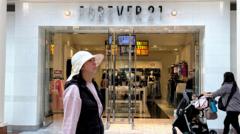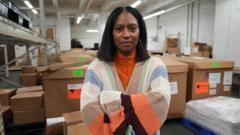Live shopping is gaining traction in the US and Europe as it changes how consumers engage with products. While successful for some, its long-term viability remains debated as cultural and market differences may pose challenges. Leading brands dive into this phenomenon, but hesitation remains among analysts.
The Rise of Live Shopping: Is It Here to Stay?

The Rise of Live Shopping: Is It Here to Stay?
Live shopping is transforming the retail landscape, blending entertainment with e-commerce. But will it resonate beyond its initial appeal?
Live shopping is emerging as a revolutionary way to shop, blending the elements of traditional retail with engaging live-streaming technology. The phenomenon, which has thrived in the Asia-Pacific region for some time, is finally making its mark on Western markets, with brands in the US and Europe experimenting with this interactive sales style.
Kelsey Krakora, a Cleveland-based entrepreneur, made a significant career shift in 2021 from a full-time job in a steakhouse to becoming a live shopping host. Transitioning to platforms like Whatnot and Poshmark, Krakora's prominence in live shopping began with a modest start. "My first live show with Poshmark was 27th November 2022. I sold zero things on my first show... but that didn't last long!" Nowadays, she sells around 100 items per show, averaging roughly $1,000 in sales per event.
Representatives from the live shopping sector argue that this model is shifting consumer habits, allowing them to shop from the comfort of their homes in a casual, inclusive manner. This trend is seen as a response to the decline of traditional shopping channels and an adaptation to modern, fast-paced purchasing options enabled by platforms like Amazon.
Estimates suggest that the live shopping market has grown to an impressive $32 billion, with notable strength in sectors like fashion, cosmetics, and collectibles. Recent surveys indicate that 45% of US consumers have engaged with live shopping events in the past year, marking a significant cultural shift.
Guillaume Faure, CEO of LiveMeUp, notes that live shopping gained momentum through social media innovations like Instagram Reels and YouTube Shorts. Interactive formats, such as tutorials about product usage during live events, enhance the experience, further attracting viewers.
However, skepticism lingers among analysts, who suggest that the model may not have universal appeal. Sucharita Kodali, a retail analyst with Forrester Research, explains that live shopping's successes in regions like China may not translate to the US, where consumers often prefer the tactile experience of physically trying on clothing before purchase.
Moreover, concerns about addiction to live shopping streams have surfaced. Bruce Winder, a retail analyst, warns that the immersive nature of these events can lead consumers to overindulge in impulse purchasing.
Despite the challenges, major brands have swiftly integrated live shopping into their marketing strategies. Companies like Nordstrom, Samsung, and L'Oreal are testing the waters, showcasing new products and discounts in live formats, elevating consumer interaction beyond standard online shopping experiences.
Illustrating live shopping's adaptability, high-end fragrance brand The House of Amouage partnered with Nordstrom to leverage its successful livestreaming strategy initially tested in China. Renaud Salmon, the firm's chief creative officer, highlighted the benefits of real-time customer feedback as they transitioned from traditional surveys to engaging directly with consumers during live events.
Though live shopping is steadily gaining popularity, its long-term sustainability remains to be seen, especially as analysts ring alarms about potential market limitations. Nonetheless, as brands explore how to best harness this new avenue, the future of live shopping is undoubtedly a captivating space to watch.
















